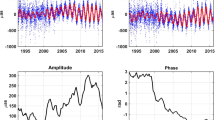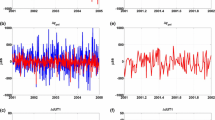Abstract
Precise transformations between the international celestial and terrestrial reference frames are needed for many advanced geodetic and astronomical tasks including positioning and navigation on Earth and in space. To perform this transformation at the time of observation, that is for real-time applications, accurate predictions of the Earth orientation parameters (EOP) are needed. The Earth orientation parameters prediction comparison campaign (EOP PCC) that started in October 2005 was organized for the purpose of assessing the accuracy of EOP predictions. This paper summarizes the results of the EOP PCC after nearly two and a half years of operational activity. The ultra short-term (predictions to 10 days into the future), short-term (30 days), and medium-term (500 days) EOP predictions submitted by the participants were evaluated by the same statistical technique based on the mean absolute prediction error using the IERS EOP 05 C04 series as a reference. A combined series of EOP predictions computed as a weighted mean of all submissions available at a given prediction epoch was also evaluated. The combined series is shown to perform very well, as do some of the individual series, especially those using atmospheric angular momentum forecasts. A main conclusion of the EOP PCC is that no single prediction technique performs the best for all EOP components and all prediction intervals.
Similar content being viewed by others
References
Akulenko LD, Kumakshev SA, Markov YuG (2002) Motion of the Earth’s pole. Dokl Phys 47: 78–84
Akulenko LD, Kumakshev SA, Markov YuG, Rykhlova LV (2002) A model for the polar motion of the deformable Earth adequate for astrometric data. Astron Rep 46: 74–82
Akulenko LD, Kumakshev SA, Markov YuG, Rykhlova LV (2002) Forecasting the polar motions of the deformable Earth. Astron Rep 46: 858–866
Bizouard Ch, Gambis D (2005) The combined solution C04 for Earth orientation parameters consistent with international terrestrial reference frame 2005. Observatoire de Paris. http://hpiers.obspm.fr/eoppc/eop/eopc04_05/C04_05.guide.pdf
EOPPCC (2006) Earth orientatnion parameters prediction comparison campaign. http://www.cbk.waw.pl/EOP_PCC
Freedman AP, Steppe JA, Dickey JO, Eubanks TM, Sung LY (1994) The short-term prediction of universal time and length of day using atmospheric angular momentum. J Geophys Res 99: 6981–6996
Gross RS, Eubanks TM, Steppe JA, Freedman AP, Dickey JO, Runge TF (1998) A Kalman filter-based approach to combining independent Earth orientation series. J Geodesy 72: 215–235
IERS (2005) IERS Central Bureau. IERS message no. 74. http://www.iers.org
IERS (2006) IERS Central Bureau. IERS message no. 95. http://www.iers.org
IERS (2007) IERS Central Bureau. IERS message no. 113. http://www.iers.org
Jovanović B (1987) An approximation of tabulated function. Publ. Inst. Math. Belgrad 41(55): 143–148
Jovanović B (1989) An analytical representation of ephemeris data. Celest Mech 45: 317–320
Kalarus M, Kosek W, Schuh H (2007a) Current results of the Earth orientation parameters prediction comparison campaign. In: Capitaine N (ed) Proceedings of the journées 2007, systèmes de référence spatio-temporels “The celestial reference frame for the future”. Observatoire de Paris Systemes de Référence Temps-Espace UMR8630/CNRS, Paris, France, pp 159–162
Kalarus M, Kosek W, Schuh H (2007b) Current results of the Earth orientation parameters prediction comparison campaign. In: AGU fall meeting 2007, San Francisco, California, Earth’s reference system and rotation: geodesy and geoscience III posters. Eos Trans AGU 88(52), Fall Meet. Suppl., Abstract No: G43C-1480
Kalarus M, Kosek W, Schuh H (2008) Summary of the Earth orientation parameters prediction comparison campaign. EGU General Assembly 2008, EGU abstract: EGU2008-A-00595
Kalarus M, Luzum BJ, Lambert S, Kosek W (2006) Modelling and prediction of the FCN. In: Proceedings of the journées 2005 systèmes de référence spatio-temporels, pp 181–184
Kosek W, Kalarus M, Niedzielski T (2008) Forecasting of the Earth orientation parameters—comparison of different algorithms. In: Capitaine N (ed) Proceedings of the journèes 2007, systèmes de référence spatio-temporels “The celestial reference frame for the future”. Observatoire de Paris Systèmes de Référence Temps-Espace UMR8630/CNRS, Paris, France, pp 155–158
Kosek W, Rzeszótko A, Popiński W (2006) Phase variations of oscillations in the Earth orientation parameters detected by the wavelet technique. In: Proceedings of the journèes 2005 systèmes de référence spatio-temporels, pp 121–124
Kosek W (2010a) Future improvements in EOP prediction. In: Procedings of the IAG 2009, “Geodesy for planet earth”, August 31–September 4, 2009, Buenos Aires, Argentina (accepted)
Kosek W (2010b) Causes of prediction errors of pole coordinates data. In: Proceedings of the 6th Orlov’s conference, “The study of the Earth as a planet by methods of geophysics, geodesy and astronomy”, June 22–24, 2009. MAO NAS of Ukraine, Kiev, Ukraine, pp 96–103
Luzum BJ, Wooden W, McCarthy DD, Schuh H, Kosek W, Kalarus M (2007) Ensemble prediction for Earth orientation parameters. EGU General Assembly 2007, EGU abstract: EGU2007-A-04315
McCarthy DD (1996) IERS Conventions. IERS Technical Note 21, Observatoire de Paris
McCarthy DD, Luzum BJ (1991) Prediction of Earth orientation. Bull Geod 65: 18–22
McCarthy DD, Petit G (2004) IERS conventions (2003). International Earth Rotation and Reference Systems Service (IERS)
Tabachnick BD, Fidell LS (1996) Using multivariate statistics, 3rd edn. Harper Collins, New York
Author information
Authors and Affiliations
Corresponding author
Rights and permissions
About this article
Cite this article
Kalarus, M., Schuh, H., Kosek, W. et al. Achievements of the Earth orientation parameters prediction comparison campaign. J Geod 84, 587–596 (2010). https://doi.org/10.1007/s00190-010-0387-1
Received:
Accepted:
Published:
Issue Date:
DOI: https://doi.org/10.1007/s00190-010-0387-1




